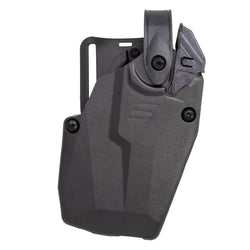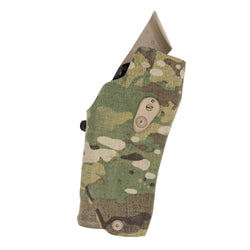One of the best developments in modern policing and military forces has been the increased focus on first aid. That emphasis has spread from uniformed troops to the average Joe and concealed carrier. More people than ever are equipped with Individual First Aid Kits, proper training, and tourniquets.
Lives are being saved thanks to the widespread availability of medical training and modern medical gear like tourniquets and hemostatic gauze.
This is a massive discussion—first aid and trauma medicine can fill volumes. With that in mind, we’re narrowing the focus today to tourniquets, or TQs, as they’re often called.

Tourniquets are devices designed to stop bleeding via pressure. They compress a limb to constrict blood vessels and limit blood flow. One of the universal rules of trauma care is simple: the more blood you keep in your body, the better.
Tourniquets have been around for a long time, but they’ve seen major advancements over the past two decades. The Global War on Terror (GWOT) made them common, affordable, and highly effective. Researchers estimate that tourniquets saved up to 2,000 lives during the GWOT.
Are Tourniquets Dangerous?
Let’s address this up front: yes, having a tourniquet tightened for hours and hours can cause complications, but it’s unlikely to kill you. What will kill you is bleeding out.
TQs keep you from bleeding out.
Choosing a Tourniquet
There are well over a dozen different companies out there showing off a variety of different tourniquets in different configurations and sizes. Choosing the right one is an important decision.
I’m no doctor, so I couldn’t possibly suggest which is the best one. The good news is I don’t have to. The Committee on Tactical Combat Casualty Care (CoTCCC) has already done the hard work. This Committee is made up of representatives from across the military, specialized physicians, and enlisted medical specialists.

They make data-driven decisions on a variety of casualty care topics, including which tourniquets work. CoTCCC maintains a list of approved TQs. It’s important to note that just because a TQ isn’t on the list doesn’t mean it won’t work; but we do know the TQs on this list do work.
The current approved list includes:
Combat Application Tourniquet (CAT) Gen 7
Ratcheting Medical Tourniquet -Tactical (RMT-T)
SAM Extremity Tourniquet (SAM-XT)
SOF Tactical Tourniquet – Wide (SOFTT-W)
Tactical Mechanical Tourniquet (TMT)
TX2” Tourniquet (TX2)
TX3” Tourniquet (TX3)
The CAT Gen 7 is my personal go-to. It’s widely available, works well, and I’ve received extensive training with it. However, any of these options will work and serve you well.

When purchasing a TQ, I recommend buying directly from the manufacturer or a reputable, authorized seller. Avoid eBay, Amazon, and similar sites. It’s way too easy to get a counterfeit, and tourniquets are popular targets for cheap Chinese fakes.
Carrying a Tourniquet
A tourniquet is used in emergencies involving severe extremity bleeding. With that in mind, you want to carry your tourniquet in an easy-to-grab fashion—you don’t want to scramble for it.
Safariland recently released its TQ System, which mounts to the front of your holster. Just like your firearm, your tourniquet should be immediately accessible in an emergency.

Do you see what I’m getting at? Positioning the TQ on your holster makes it accessible and easy to reach. If that setup doesn’t appeal to you, the pouch can be mounted to a belt or onto a MOLLE platform.
The pouch is made of polymer and has an open top for quick and easy drawing. Safariland designed it for the CAT and similar TQs, so it works quite well for me.
If this isn’t a solution for you, that’s fine. I’d advocate for placement that’s easy to reach and out of the way. You want quick and easy access to your TQ when you need it.
How To Apply a Tourniquet
Let me preface this by saying: get Stop the Bleed training. Reading a how-to is no substitute for hands-on experience. Think of this as proof of how easy a tourniquet is to use and why everyone should have one.
First, identify the wound and, if possible, remove any clothing from the area. Suppose you carry a full IFAK and attempt to apply firm, direct pressure with a clean cloth. If the pressure doesn’t work, it’s time to use the TQ.

You want to aim to place the TQ two to three inches above the wound. If there are multiple wounds,apply the tourniquet as high as necessary to control the bleeding. In a situation where you can’t locate the wound due to low visibility, go as high as you can.
You want the TQ between the wound and the heart. Never apply a tourniquet over a joint like a knee, ankle, or elbow. It will not work because the joint structure protects blood flow and prevents proper compression.

Most tourniquets are sort of buckle-like. Pull the TQ as tight as you can and use any locking device, like Velcro, to keep the slack out. The rod attached to the tourniquet is called the windlass.
Use the windlass to further tighten the TQ until the bleeding stops or you physically can’t tighten it any more. This will not be comfortable for your patient.

TQs include a means to secure the windlass; do so. If the TQ is as tight as it can go and the wound keeps bleeding, you can apply a second one. If possible, place the second TQ above the first and tighten it down as much as possible.
After applying a TQ, note the time and provide that information to medical professionals. Never loosen a TQ; that isthe responsibility of higher levels of medical care. Tourniquets can also be used in combination with hemostatic gauze or standard gauze to further reduce blood loss.
Life Savers
If you can make holes, you should know how to patch them up. A TQ is a simple solution for hemorrhage control. It’s an invaluable piece of kit and the only life-saving piece of gear I know that costs less than $50.
There’s no excuse not to carry one, especially if you’re in law enforcement. Pair it with proper training, and you’ll be better prepared to act when it matters most. Carry one, keep it accessible, and be ready to use it.











